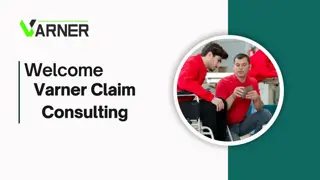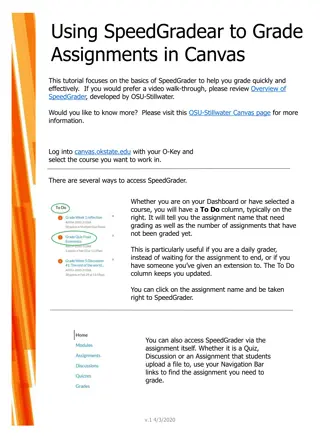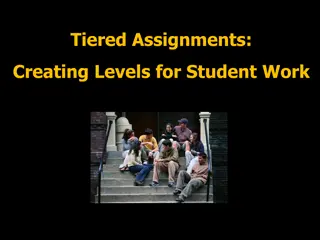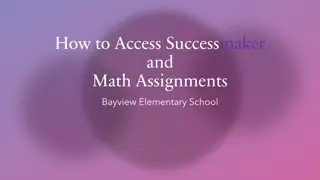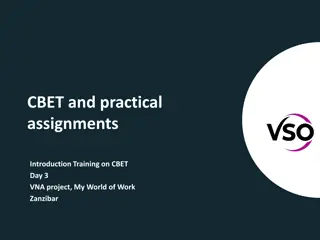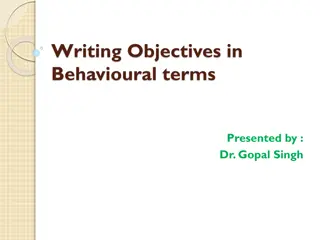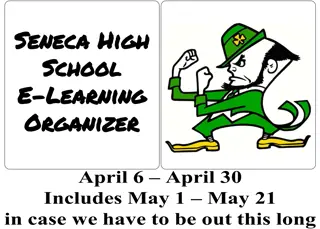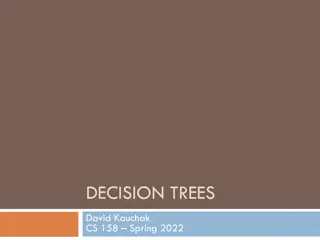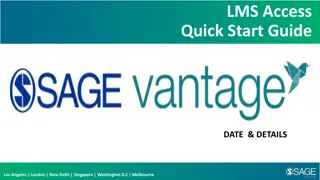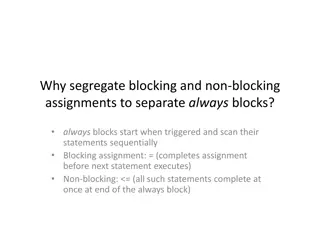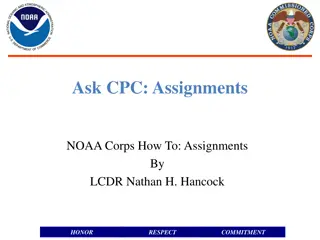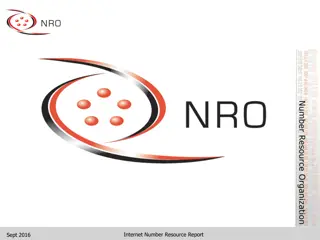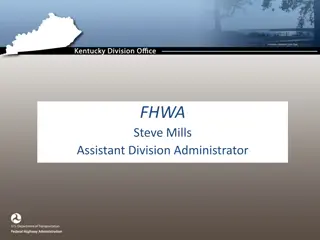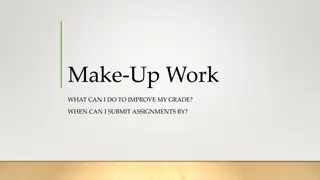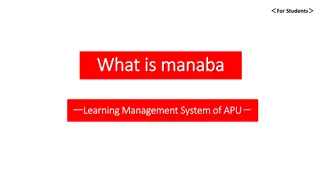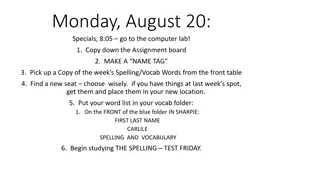Learning Objectives in Assignments
Defining learning objectives as specific outcome statements, this content explores their importance in structuring learning, connecting content with assessment, and setting expectations for students. It covers Blooms Taxonomy, outcomes-based models, and the characteristics of SMART learning objectives. Practical guidance is provided on writing effective learning objectives and evaluating teaching strategies to meet student needs.
Download Presentation

Please find below an Image/Link to download the presentation.
The content on the website is provided AS IS for your information and personal use only. It may not be sold, licensed, or shared on other websites without obtaining consent from the author.If you encounter any issues during the download, it is possible that the publisher has removed the file from their server.
You are allowed to download the files provided on this website for personal or commercial use, subject to the condition that they are used lawfully. All files are the property of their respective owners.
The content on the website is provided AS IS for your information and personal use only. It may not be sold, licensed, or shared on other websites without obtaining consent from the author.
E N D
Presentation Transcript
Learning Objectives & Using Technology in Assignments Alyssa DeBlasio (Dickinson College, USA) deblasia@dickinson.edu
Part I: Learning Objectives (Part II: Blended Learning)
Learning Objectives A learning objective is an outcome statement that captures specifically what knowledge, skills, attitudes learners should be able to exhibit following instruction. (Rutgers U) Example: After successful completion of the course/unit/ assignment/lecture, students will be able to VERB Why? Helps structure learning and syllabi Connects content with assessment Connects courses with program Students know what to expect Because we have to!
Blooms Taxonomy: A Vocabulary for Instruction
Outcomes Based Model student-centered & results oriented (taught but learned) quality teaching = students who demonstrate learning Unity: content, method, and results should be unified by learning objectives and then assessed Instructor must: (1) clearly identify what students will learn (2) understand student progress is based on demonstrated achievement (3) use multiple pedagogical strategies to address all needs (4) assess these strategies
Learning Objectives Learning Objectives should be SMART Specific Measurable Attainable for target audience Results-focused & Relevant Target-focused to the learner and learning level (U of North Carolina Wilmington, http://uncw.edu/career/documents/WritingSMARTLearni ngObjectives.pdf)
Writing Learning Objectives After successful completion of the 16 hour workshop, participants will be able to (1) identify and summarize many of the main components and strategies of successful English-language courses, with particular emphasis on the following areas: writing syllabi, composing learning objectives, using blended learning techniques, sequencing assignments, and assessing assignments; (2) evaluate the above components and strategies in relation to their own teaching; (3) create a sample assignment for an English-language course with at least one learning goal, with a digital component, and with an assessment plan.
Workshop Website: http://blogs.dickinson.edu/deblasio/learning- objectives/ In the Google doc, write the learning objectives for your course.
Blooms Taxonomy and Keywords Remembering: recognizing, listing, describing, identifying, retrieving, recalling, naming, locating, finding Understanding: interpreting, summarizing, inferring, paraphrasing, representing, classifying, comparing, explaining, exemplifying, translating Applying: implementing, carrying out, using, executing Analyzing: comparing, organizing, deconstructing, attributing, outlining, finding, structuring, integrating, focusing, selecting, parsing Evaluating: checking, hypothesizing, critiquing, experimenting, judging, testing, detecting, monitoring, coordinating Creating: designing, constructing, planning, producing, inventing, devising, making, generating
Checklist for Learning Objectives 1. Start each objective with an action verb from Bloom s taxonomy 2. Focus on outcomes, not processes 3. Avoid vague verbs like know and understand 4. Ensure that objectives are observable and measurable 5. Write the objective in terms of the student, not the teacher 6. Check that the outcomes reflect knowledge, skills, etc. that are important for the course and the program Three main questions: 1. What do you want to accomplish? [syllabus] 2. How are you going to accomplish it? [assignments] 3. How you will measure it? [assessment & grading]
Blended Learning / Hybrid Pedagogy Hybrid Pedagogy (March 5, 2015): supporting students through a process of consuming, creating, and filtering content on the internet in a way that gives them ownership of their learning while also teaching them essential curation and critical thinking skills (Hudson, http://www.hybridpedagogy.com/journal/teaching-as-wayfinding/) Babson Survey Research Group & Pearson: students report (1) higher levels of connection to the class ; and (2) learning that extends beyond classroom and is more relevant to real life when social media (blogs, podcasts, etc.) are incorporated into syllabi
Technologies for Teaching 1. Blogging: wordpress.com, blogger.com 2. Podcasts: Audacity (PC and Mac) 3. Video: Windows Movie Maker (PC), iMovie (Mac)
1. Blogging journaling and/or reflection pieces Intermediate Russian language blog: http://2012russ200.blogspot.ru Spanish for Business Spring 2015: http://blogs.dickinson.edu/spanbusiness-spr15/ pre-class assignments to help in-class discussion or post-class discussion Communism & the Environment blog: http://blogs.dickinson.edu/hist315-enst311- sp12/2012/02/29/downstream-valentin-rasputin/ used to track progress on a long-term research project, like a course paper or thesis For instance, Post 1 could be a list of potential topics; post 2, 2-3 primary sources on a chosen topic; post 3, a research proposal; post 4, a progress report; post 5, a draft of a section of the paper. The benefit of having students do this on a blog is that you can put them into peer editing groups and students can give one another feedback online http://cft.vanderbilt.edu/guides-sub-pages/blogs/ collaborative work / class project Mapping NYC Modernism: http://nycmodernism.princeton.edu Historical Markers of Virginia: http://fredmarkers.umwblogs.org connect different classes, departments, programs, or universities RSUH and Dickinson professor exchange: http://blogs.dickinson.edu/rsuh/ course portfolio / student portfolio Digital Resume: https://chasephilpot.wordpress.com
2. Podcasts Learning a language record speaking and reading; practice dialogues and vocabulary; receive comments from instructors and class members https://soundcloud.com/groups/russ-101-fall-2013 Text annotation comment on a reading http://www.dickinson.edu/info/20030/russian/67/tyutchev_poem http://blogs.dickinson.edu/latin-poetry-podcast/2013/01/16/i-hate-and-i-love- catullus-85/ Music students can share and promote their work Public speaking practice public speaking in low-stakes environment Radio broadcast & storytelling promoting university events; preparing short informational stories; incorporating oral history or interviews http://dcc.dickinson.edu/view-podcasts-caesar Oral reports used in place of oral or written reports or essays
3. Video Audiovisual essay Intro to Arts of Asia: http://blogs.dickinson.edu/introartsofasia/2010/12/13/evolution- of-buddhism-2/ TED talk style assignment or Thug Notes style assignment http://www.youtube.com/watch?v=Rm4lLxNvfAA Recorded lectures https://vimeo.com/album/2446220/video/70662122 The Mixxer / Skype http://www.language-exchanges.org
Workshop Website: http://blogs.dickinson.edu/deblasio/learning- objectives/ In the Google doc, now write a blended learning assignment that achieves at least one of your learning objectives.
http://kb.bcit.ca/files/articles/fsr/teach/courseprep /ja_learningoutcomes.pdf





